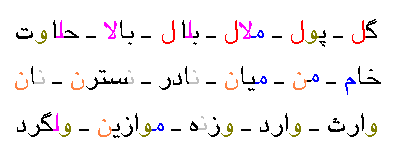As you know, practice makes perfect! Every week, along with each lesson, you are given some words to practice. I know that, as a beginner, you will find it difficult to read the entire words by yourself. Therefore, you are not asked to either read or write these words at this stage. Please do not try to pronounce these words on your own or you will remain in an insolvable confusion for good. All you have to do is identify the letters you have already studied. So, first go to the This week and study the new lesson carefully. Then click on the Useful drills button to get connected to this page. On this page you will find some words that seem quite stranger to you at the first glance. Nevertheless, you must at least be able to recognize the letters you have just studied on This week. And this is all I want you to do.
NOTE: as you see in the following words, there are no symbols (signs)on or under the letters. We, as beginners, use these symbols during our lessons to learn the correct pronunciation of the words. Later, after you got enough familiarity with the words and the way they are pronounced you would find it redundant to use these symbols with letters, except for some ambiguous words that are not used very often. I have eliminated these symbols on purpose to let you see the real Persian words that take no symbols with them.
Notes: 1- it is recommended that you visit Let’s Write page first before doing these exercises. It will certainly help you a lot with detecting the letters.
2- please pronounce the letters that we have already studied. For those letters that we haven’t studied yet, just find what you are asked but don’t pronounce them.
3- As you see, persian letters have ‘dots’ with them. Some letters may have up to three ‘dots’ while some others have no ‘dots’.
Questions:
In the following words, how many. do you detect?
1. Big letter ![]() /la:m/?
/la:m/?
2. Small letter ![]() /la:m/?
/la:m/?
3. ![]() /mim/, both small and big?
/mim/, both small and big?
4. Big letter ![]() /nu:n/?
/nu:n/?
5. Small letter ![]() /nu:n?
/nu:n?
6. ![]() /va:v/?
/va:v/?
Note: in addition to these questions, you may find other letters that we have already studied. To keep yourself updated, you’d better find those letters as well. For example, you may find ![]() or
or ![]() or and so on.
or and so on.
Please try to answer the questions first. Then, if you want to be sure, find the correct answers at the bottom of the following words.
The answers:
1. 4
2. 5
3. 5
4. 5
5. 4
6. 7
Pictorial answers:
1 – 2 – 3 – 4 – 5 – 6


Aylin
March 10, 2015 @ 7:19 pm
Hi from Istanbul,
I am little confused both about /va:v/ and long vowel /u:/
At the last question for example, how can i be sure if it is a letter or a long vowel. Or shouldn’t i worry about it?
Emily
January 22, 2016 @ 11:58 pm
I have the same question. So in this exercise, if it is pronounced Vav, should we still count u: when its function is a long vowel?
Jeannette Martin
February 17, 2017 @ 2:49 pm
Thanks for making this easy but very useful program! I studied Persian 40 years ago and it is good to learn again.